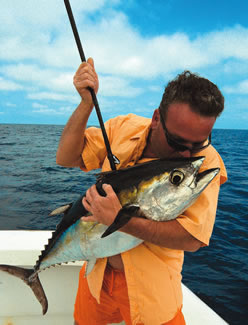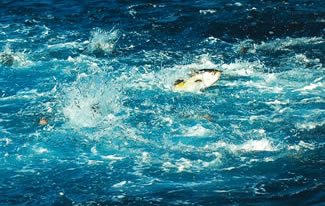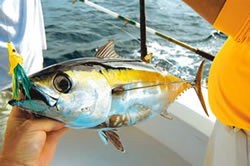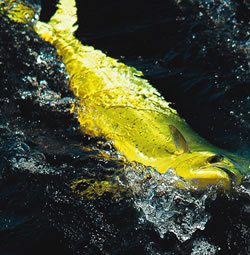May 16, 2011
By Randy Rode
Fishing seamounts and other deepwater structure, Florida Keys-style.
By Randy Rode

Blackfin tuna are a major draw on the Keys hump, including the one off Marathon. |
One of my favorite places to fish in the Florida Keys is known, simply enough, as the Hump. The Hump was originally called the West Hump, because it is the westernmost in a series of three humps, located on the edge of the continental shelf off of the middle Florida Keys.
In the 1970s, I began to call this area the Marathon West Hump in an attempt to promote it as a fishing destination off Marathon, due to the fact that a prominent hump off nearby Islamorada had been known for years as the “Islamorada Hump.” The Marathon West Hump lies approximately 30 miles offshore of the Middle Keys, on a course of 135 degrees from Marathon.
These humps are loosely called seamounts, because they are like mountains rising from the ocean floor. Worldwide, there are thousands of these structures. Some are remnants of underwater volcanoes; others may have once been emergent islands. Wherever you find them, seamounts are unique marine habitats. They alter currents, and provide structure for fish in the otherwise featureless depths.
Over the years we've developed some special techniques for fishing the Humps in the Keys. Perhaps you'll try them on your next trip to this part of Florida, or apply what you learn to other deepwater structure you find.
Let's take a closer look at that Hump off Marathon.

Tuna frenzy on the Islamorada Hump. |
Our Hump, as we in Marathon call it, is located almost exactly in the middle, or the axis, of the Gulf Stream, where the current runs the hardest, indicated by the highest water temperature. If you were to graph the water temperature, while transiting the Gulf Stream, the surface water temperature would slowly rise, with the highest temperature in the centerline of this powerful ocean current. The shallowest part of the Hump is 480 feet from the surface, rising from a depth of 830 feet on the west, or upcurrent side, and dropping to nearly 1,200 feet on the east, or downcurrent side.
As the Stream pushes northeastward, sometimes reaching a velocity of 3 to 4 knots or more, it slams into an immovable pinnacle of solid rock, effectively blocking more than one half of the water column. In order for the water to get by this choke point it speeds up, creating an upwelling, a phenomenon where colder, oxygen-rich water rises to the surface. This is a perfect environment for maximum productivity, starting with baitfish, bigger baitfish and, finally, top-of-the-line predators.
The list of gamefish caught on the Hump includes dolphin, wahoo, blackfin tuna, huge amberjack, blue marlin, sailfish, white marlin and big sharks, chiefly makos and great whites. Fishing deep on the bottom, you might catch snowy grouper, queen snapper and a variety of other bottom dwellers.

Small feathers are deadly on blackfins. |
Techniques for fishing this area have changed over the years, following advances in electronic fish-finding and position-fixing technology. During the 1950s and ‘60s, the Hump was found by running time, speed and distance courses, and then looking for the characteristic rip, caused by the Gulf Stream slamming into that 720-foot-high underwater obstruction. The success rate for locating a one-acre pinnacle in over a thousand feet of water ran about 50 percent, sometimes higher when the water was very calm, when you could see the rip caused by the powerful upwelling.
In the 1970s, we found the Hump using Loran-A, tricky and sometimes unreliable. Synchronize the sine waves, and don't ever turn the machine off, once it locked in.
By the 1980s we had Loran-C, more reliable, but still crude by modern standards. My first Loran-C was an SRD-CLX, a huge machine about half the size of an old-fashioned bread box and costing $3,000; that's a lot of full-day trips back in those days! This machine had the “unbelievable” capability of displaying two lines of position at the same time. Since the 14,000-microsecond delay line runs nearly parallel to the 135-degree course to the Hump from Marathon, all I had to do was to keep on that line, and run down the 43,000 line until it read 43358.2. Forget about course to destination, course steered, time to go, cross track error, and all that; information like that was still years away. To this day, the Loran-C coordinates of the peak of the hump are indelibly etched into my memory, 14032.6 and 43358.4. In fact, when I fish there now, I have to consult the chart to get the Lat/Long coordinates, which are 24-25.528-N and 80-45.328-W.

Dolphin visit the forage-rich rips that form where the Gulf Stram hits the humps. |
Deep-dropping for amberjack, grouper and deepwater snappers was accomplished by a technique that I developed by trial and error. The dropping rig was made up of several sections. The bottom-most part of the deep-dropping rig was a standard size concrete block (I used to get the rejected ones from the plant free to save money). To keep the breakaway portion of the rig from chafing on the way down to the bottom, I tied a piece of 30- or 50-pound-test monofilament around the block; this part we called the “harness.” The breakaway portion of the rig was tied to the harness; it absolutely had to be 20-pound monofilament. This we determined by more than several breakoffs on the way down, using less than 20-pound test, and the unthinkable reeling up of a concrete block from 800 feet of water by hand when a heavier line didn't break. The breakaway portion was tied to the second hook of a two-hook, freshly caught butterflied bonito or tuna rig.
To get properly positioned for dropping, you would locate the crown of the hump, and then run exactly 240 degrees, the reciprocal course of the Gulf Stream. The distance you ran, depended on the strength of the current, but almost always required running upcurrent to the base of the hump, or beyond, to about 800 feet of water.

Amberjacks, tunas, big sharks and more hang out over the humps.
To effectively fish this rig, due to the fact that the weight was fixed to the second hook, you would drop the bait as fast as possible, while backing down in the direction of the wind, trying to keep the angle as nearly straight up and down as possible. When the bait reached the bottom, we left the rod in the rodholder, locked up the drag, and waited for the rod to bend over. When the rod went down, sometimes double, we'd wait for the weight to break off, relieving pressure on the rod. A bite was telegraphed by a slight pressure, at which time the captain would throttle ahead to help set the hook.
Seamount Stewardship |
With the advent of reliable and accurate position-locating systems, fragile ecosystems, such as seamounts and humps, have been received increased fishing pressure in recent years. It is important to remember these areas are prone to overfishing, and must be protected and regulated.
In addition, there is unwritten protocol to fishing these areas, when many boats are fishing the same, relatively small spot. Due to the fact that many anglers fish their baits very far behind the boat, cutoffs are frequent. Fishermen must recognize that in order to effectively fish these deepwater oases, they must be courteous to other boaters.
There many undiscovered seamounts and humps worldwide, and chances are that there may be an excellent, untapped spot within your fishing locale.
Every time I go fishing, after warming up the engines and turning on all the electronics, I refer to my depthfinder often, looking for new bottom. I look for surface rips that might indicate the presence of underwater structure. I look for baitfish and diving birds that might indicate the characteristic upwelling of a hump.
Every day fishermen are discovering new waters to fish, taking pressure off the well-known, regularly fished spots, and opening up entire new areas to the excitement of fishing a previously unknown area, a biologically diverse, unique micro-ecosystem known as a seamount.
Advertisement
|
|
Most times the fish would be an amberjack, but other times the angler would be rewarded with a large snowy grouper, a mako shark or even a great white!
Populations of different species of fish usually stratify vertically on seamounts, with each species finding its own comfort zone, according to depth and water temperature. In the case of the Hump, bottom dwellers prefer to stay close to rocky structure on the seamount, while tuna and bonito are normally seen on the fishfinder at about 100 to 200 feet down. Billfish and other pelagics, such as dolphin and wahoo can be found anywhere in the water column.
The time-proven method for catching blackfin tuna on the Hump is to troll a combination of small artificials and skirted ballyhoo 150 yards behind the boat, at 7 to 8 knots. The captain locates the crown of the Hump and then trolls into the current, oftentimes chasing diving birds, and bait sprays, caused by blackfins chasing schools of flyingfish or other baits.
Modern techniques for catching blackfin tuna include anything from trolling large deep-diving artificals, run straight from the rod, or on downriggers, to chumming with live bait.
To effectively chum with live bait, the captain runs upcurrent of the crown of the Hump, and then as the bottom begins to rise, dumps several hundred live baits overboard. The schools of bait will dash beneath the boat, in an attempt to hide, but can be easily washed out by kicking an engine in gear. The tuna rise to the bait, and can be caught by sight-casting live bait on spinning tackle, or even using a fly. Many world-record blackfin have been caught while anglers used live chum.
FS
